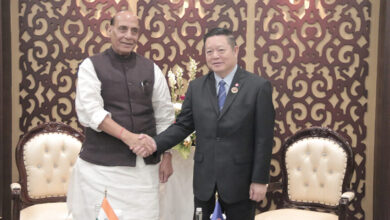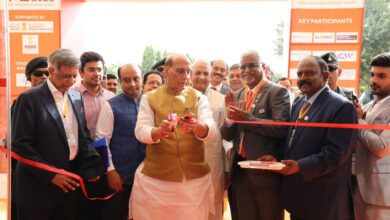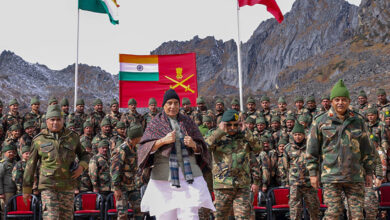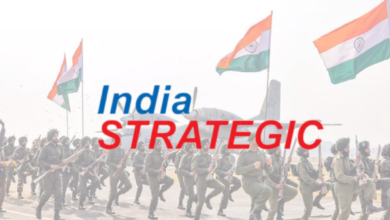India’s regional aspirations
New Delhi. The fact that India is a rapidly growing global power has been repeatedly talked about in various forums for the last 7-8 years. Our annual growth rate of around 8 % during the period lent credence to the feeling that we have arrived at the global stage.
This conviction was further reinforced by a few other factors in the course of time.
First and foremost, India was largely unaffected during the economic meltdown that shook the world in 2008. While the US and the West were the worst affected, reverberations of the meltdown were felt in all economies which were closely linked to the US, whether in Latin America or in Asia.
Secondly, availability of large, younger workforce has provided India with a distinct advantage as far as growth and development is concerned, subject of course to optimum utilisation of this workforce.
Thirdly, with the centre of gravity of world attention gradually shifting to Asia, India’s geostrategic location in the region naturally places it in a position to influence events occurring here which have an impact globally.
Finally, India, having joined the elite nuclear club, automatically places itself among the leading nations of the world, in the perceptions of a vast majority.
But there is a difference between perceptions and reality in case of India.
Our per capita income is nowhere near the leading nations of the world. We are still plagued by illiteracy, unemployment and lack of basic amenities for our citizens. Our healthcare system is unable to provide succour to our teeming millions in an appropriate fashion. Our agriculture continues to be dependent on the vagaries of monsoons and El Nino effects. Above normal rainfall leads to breakdown of infrastructure in most urban and rural areas and below normal rainfall raises the spectre of droughts.
A significant negative factor is the lack of desire for excellence in general in the Indian work force.
Of late, credibility of governance is also being questioned, thanks to a large number of allegations and scams coming to light. Sectarianism and regionalism keep raising their ugly heads on an ongoing basis. Insurgencies in J&K and Northeast and emergence of Left Wing Extremism in large parts of the country are administering a debilitating blow to the development of the country.
We tend to be more busy resolving one crisis after another rather than working towards having an organised system where the very occurrence of a crisis is avoided in the first place and if it does occur, corrective steps are thought of well in advance and implemented immediately.
Under these circumstances where is India headed in the medium to long term? Would it be appropriate to say that we are emerging on the international scene as a global power? The answer is an emphatic no.
While we possess the basic requisites to be able to reach there, unless all our resources are harnessed and optimally employed, it would be a tall order to achieve. Let alone global, even our regional responsibilities and aspirations would be in jeopardy unless we start taking corrective steps with immediate effect.
As a first step, we need to introspect that while our size and geostrategic location bestow on us the mantle of being a regional power, are we able to sustain that perception with our actions? Do we have good functional relationships with our neighbours? Do the other nations of the region look up to us for support and assistance and are we able to come up to their expectations in providing it? Have we been able to reach out to them and win their trust and confidence? These are difficult questions that need to be answered while analysing India’s regional aspirations.
The USA went through a prolonged period of “splendid isolation” before it emerged on the global scene as a leading power post Second World War and has continued to wear the mantle of global leadership since then. Students of history would testify to the fact that it used the period of isolation from world affairs to strengthen itself
internally in all spheres. Industry, agriculture, education, healthcare, commerce, military and governance- all areas were refined to make the country an economic powerhouse of the world.
China too has followed a somewhat similar route in first addressing internal shortcomings and systems, albeit under communist ideology. Since 1978, when Deng Hsiao Ping started the process of reforms, China assiduously worked on improving productivity, developing infrastructure, upgrading technology, modernising the PLA and creating global markets for its products before suddenly emerging on the global stage in the last decade.
The point to be emphasised is that India must likewise first address internal issues before venturing on to the international arena at the regional or global level. While a totally isolationist policy may not be feasible in the current environment of global linkages in most spheres, priority must lie with setting our house in order first and foremost.
India has a number of positives going for it. Our size, geostrategic location, huge workforce, frugal lifestyle, large resource base, suitable climatic conditions, surplus agriculture etc. provide the basic fundamentals which we can optimise to advantage. However, there is an equally long list of negatives which has to be contended with.
The country has time and again been exposed to communal riots and terrorism. Unemployment and illiteracy nullify the advantage of having a large workforce.
Mass scale corruption is gnawing at the roots of economy. National interest is viewed through the narrow prism of regionalism and parochialism and sought to be justified along partisan lines to derive maximum political mileage, in the process leading to a fragmented approach to national issues.
Above all, poor governance, whether at the state or central level or by one political party or the other has hampered growth and development. As a result, we are unable to realise our full potential.
The past year has seen a visible unrest among the public at large and the civil society in particular against corruption at all levels in the government and the political class. It found manifestation in the movements started by people like Anna Hazare which got tremendous backing of the educated elite in the beginning. People even questioned the credibility of the parliament to make meaningful laws for the country when a large number of its members are facing criminal charges in various courts across the country.
The waning of support for such movements has more to do with there being no suitable and viable alternatives visible on the horizon than with differences among the leadership on how to carry the movements forward or the hidden agendas of some of the leaders. However, the fact that with passage of time, more and more Indians are getting disillusioned with the governance is not in doubt. There is also disappointment at the downward slide
in the Indian economy.
As a regional power, India is expected to possess both the economic and military might to safeguard the interests of the region. In so doing, it is also expected to carry along with it most if not all the countries of the region. While differences between neighbours will always occur, common problems of the region like terrorism, drug trafficking, maritime piracy, natural disasters etc. need to be tackled jointly in a cooperative environment.
India is expected to take the lead in setting up mechanisms to solve such problems and contribute a major share towards financing them. Mutual differences with regional countries also need to be resolved amicably in a spirit of give and take.
It is, therefore, important to first address internal issues, become strong economically and militarily, before venturing outwards to becoming even a regional power in the true sense of the word.
To quote from the Prime Minister’s speech on 20 Sep 2012, “The world is not kind to those who do not tackle their own problems”.





